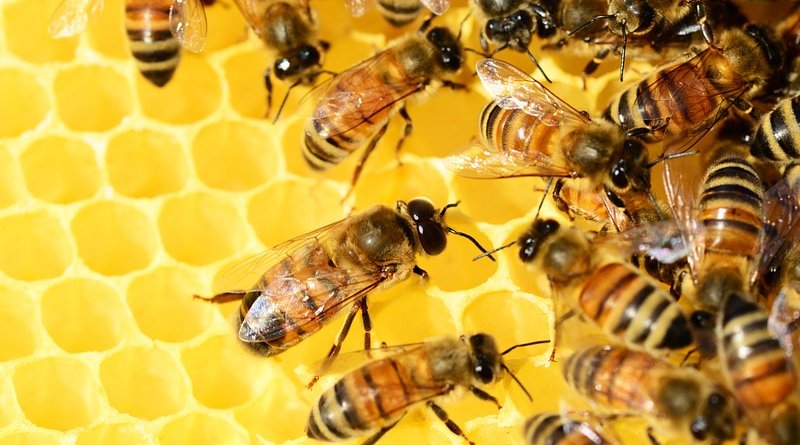A Little Prairie Can Rescue Honey Bees From Famine On The Farm
Scientists placed honey bee hives next to soybean fields in Iowa and tracked how the bees fared over the growing season. To the researchers’ surprise, the bees did well for much of the summer. The colonies thrived and gained weight, building up their honey stores. But in August, the trend reversed. By mid-October, most of the honey was gone and the overwintering brood was malnourished, the team discovered.
“We saw a feast-or-famine kind of dynamic happening, where in the middle of the summer they were doing great. In fact, the hives in highly agricultural areas outcompeted hives in areas with less soybean production,” said Amy Toth, a professor of ecology, evolution and organismal biology at Iowa State University who led the research with ISU entomology professor Matthew O’Neal and University of Illinois entomology professor Adam Dolezal.
“But then they all just crashed and burned at the end of the year,” Toth said.
In further experiments, the researchers were able to “rescue” some of the afflicted hives by moving them to reconstructed prairie sites with many late-flowering prairie plants. Those hives rebounded to healthy levels and were better prepared for winter.
The findings, published in the Proceedings of the National Academy of Sciences, offer a more nuanced view of the role of agriculture in honey bee health than was previously available, Dolezal said.
“There’s been a lot of interest in how bees respond to agriculture,” he said. “There’s been work on pesticides and predictions that the highly monocultured agricultural landscapes have lost a lot of floral resources.”
Some studies have found, however, that honey bees do better in agricultural areas than in other landscapes, Dolezal said.
“One hypothesis about that is that bees near agricultural zones have more access to flowering crops and weeds like clover than those near forests, which can have fewer floral resources,” he said.
The new research seems to support this idea. To see what plants the bees relied on, the team took samples of pollen spilled by foraging bees on their way back into the hive.
“Over the entire year, more than 60% of their pollen collection was from clover,” Dolezal said. The study did not determine which plants supplied the nectar, however.
“This experiment was designed to establish how commercial farmland surrounding a honey bee colony supports its growth and survival,” O’Neal said. “More than 80% of Iowa is dedicated to agriculture. And while the two most important crops do not require bee pollination, corn can provide pollen and soybeans produce a lot of flowers, which can be a source of nectar for honey bees. The weight gain of a hive is due to honey, which comes from nectar.”
O’Neal was surprised how often honey bees found clover in landscapes devoted to almost nothing but corn and soybean.
“Most of the field edges are mowed and can contain clover,” he said. “This little bit of land could be offering a significant source of food.”
Soybean and clover bloom until late July in central Iowa, where the study was conducted. In early August, that food supply dwindles to nothing, however.
The weight of the study hives next to soybean fields dropped, on average, more than 50% between early August and mid-October, the researchers found. The bees were eating through their winter stores before the onset of cold weather.
To survive the upcoming winter, honey bees must gather enough nectar and pollen from surrounding areas to tide them over. The nectar is used to make honey – an essential food for overwintering bees – and the pollen provides other nutrients like proteins and lipids.
As winter approaches, the last generations of bee larvae normally experience unique physiological changes that better prepare them for the harsh season.
“The winter bees have higher fat stores and their aging is slowed so they can get through the winter,” Dolezal said. “But we found that the winter bees near soybean fields did not have the same level of fat stores.”
The bees moved to prairie sites in August developed higher fat stores, however.
“This suggests that the rebound the hives experienced when we put them in the prairie also trickled down to the individual bees,” Toth said. “Their nutritional health had also improved by being in that prairie habitat.”
The researchers do not recommend that beekeepers move their hives to prairies. Remnant prairies are rare and too small for many hives, the researchers said. Overstocking with honey bees could negatively affect native bees. Instead, the team is testing an intervention that installs 5- to 8-acre strips of reconstructed prairie within or alongside agricultural fields.
These strips reduce erosion, prevent the flow of nutrients from farm fields into waterways and, perhaps, will also feed the bees at a crucial time of their life cycle, the team said.

